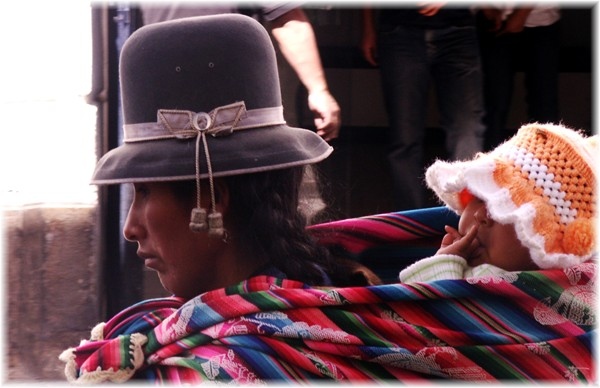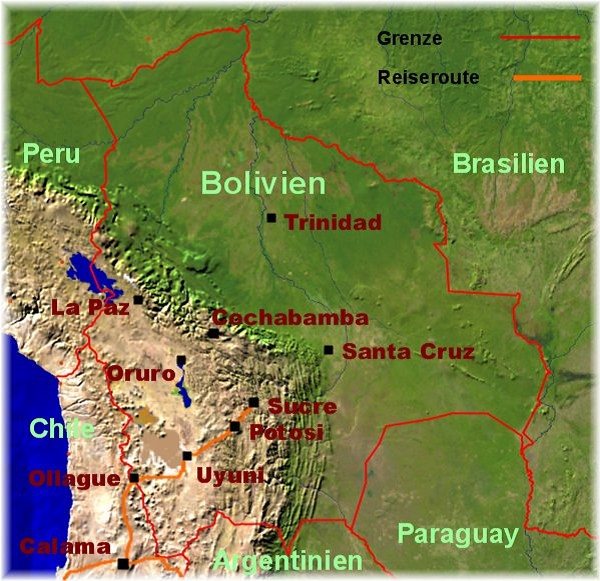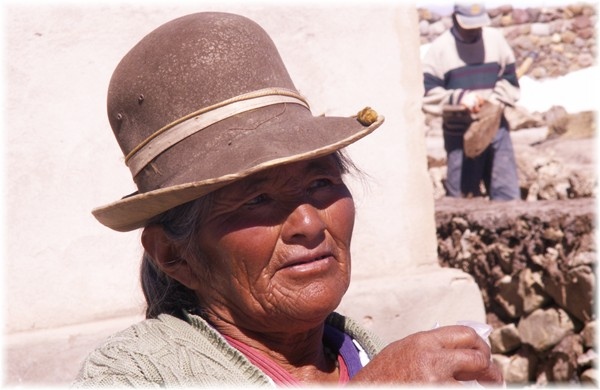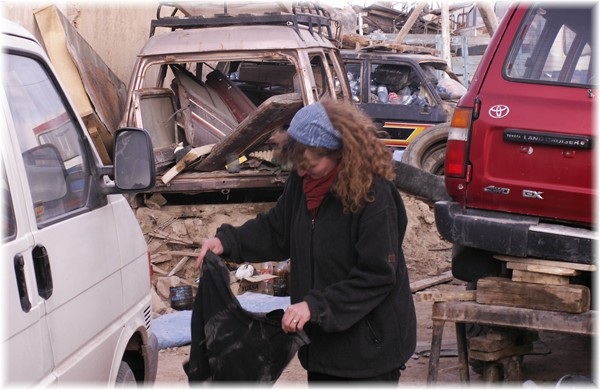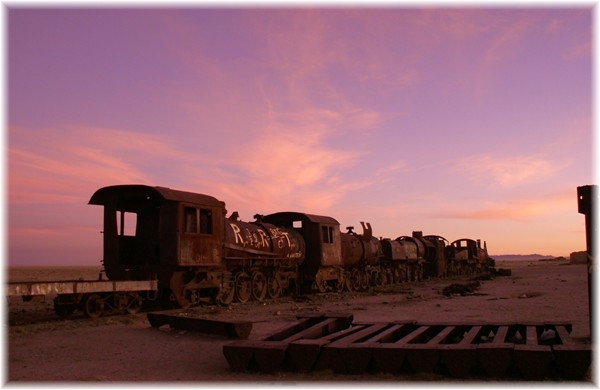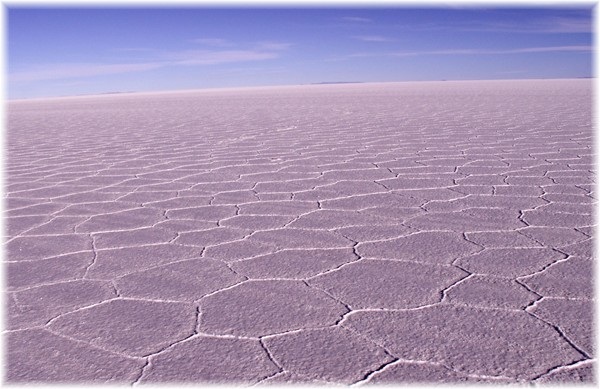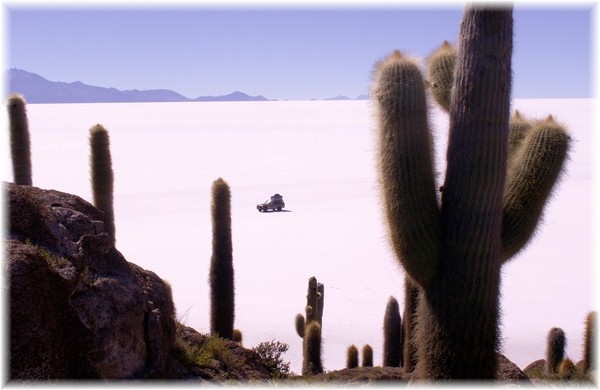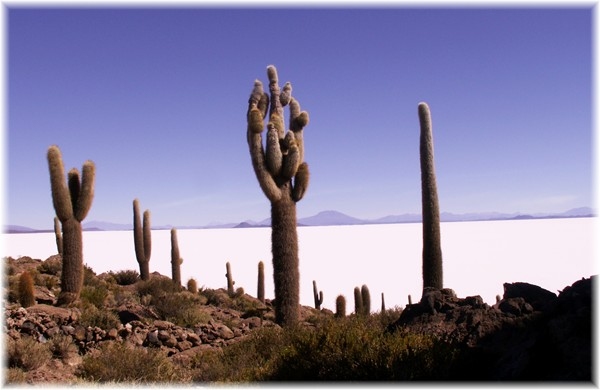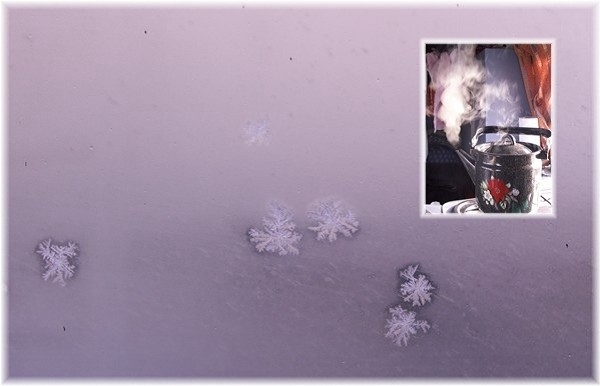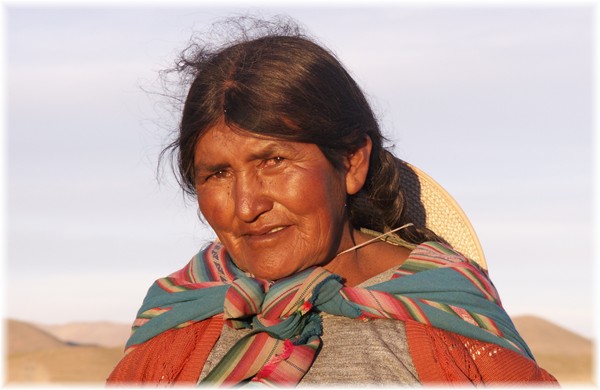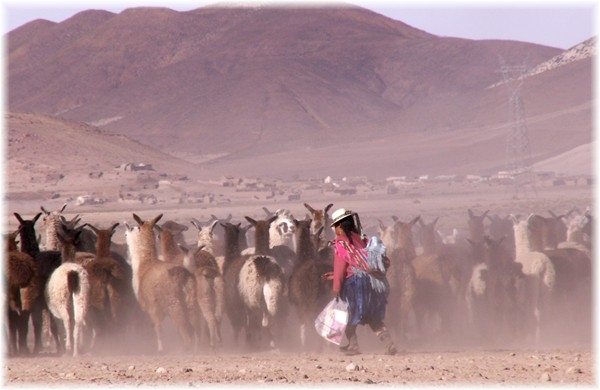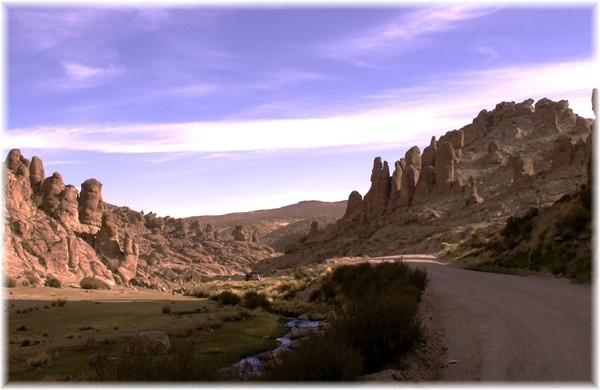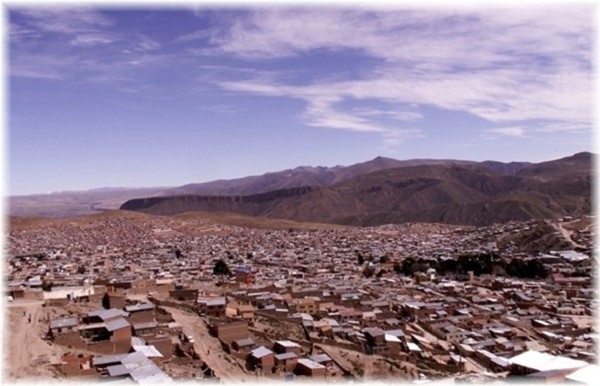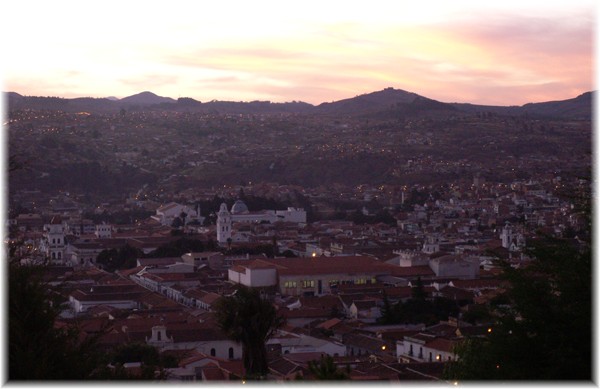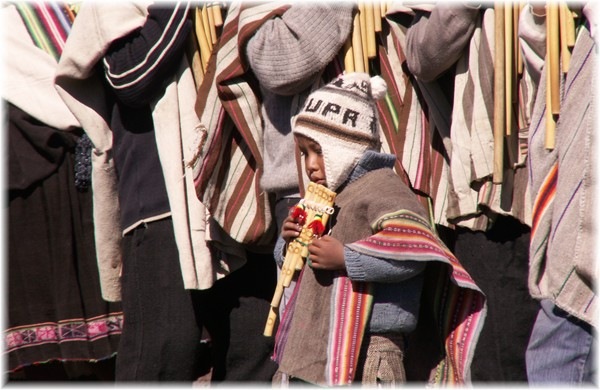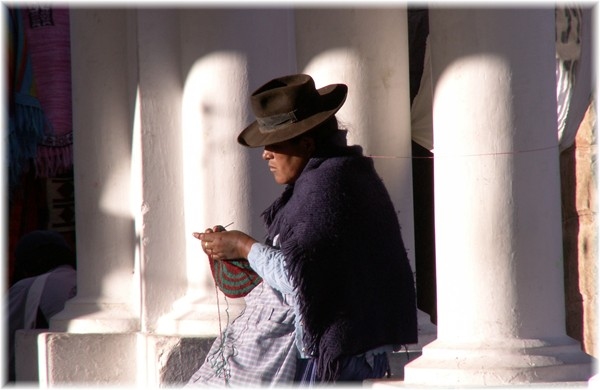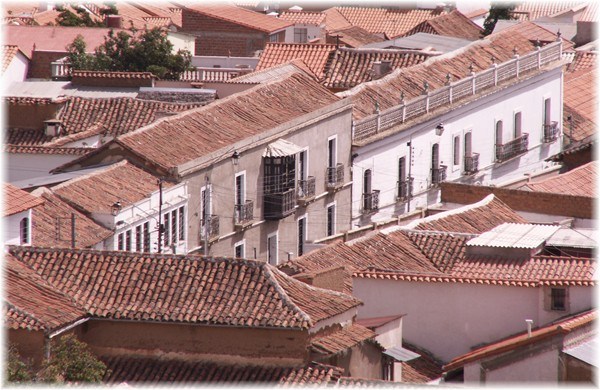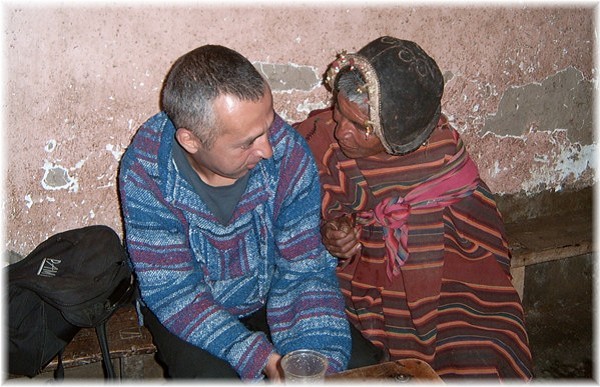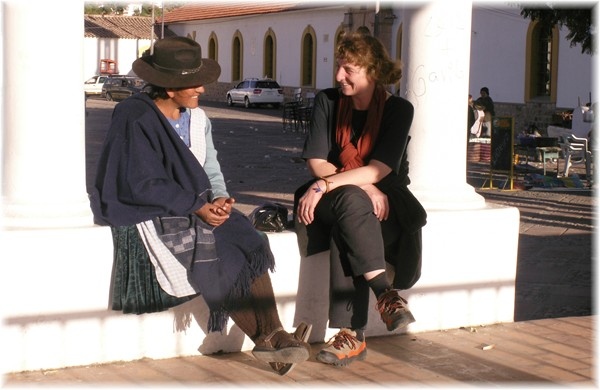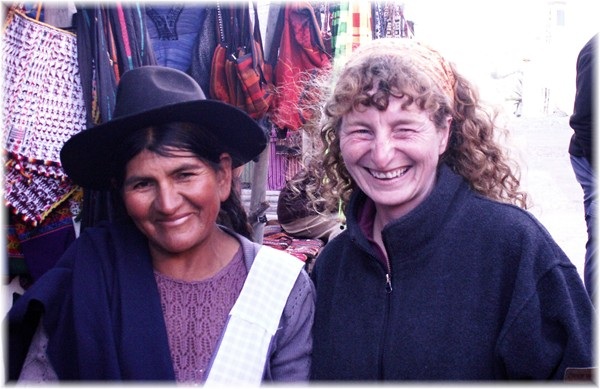A few information on the country and the politics. Bolivia is engraved in three different landscapes. In the Southwest the Altiplano, a plateau on an altitude between 3500 m and 4500 m, which is mostly deserted. In the Northeast the lowlands which is the jungle and mostly inaccessible. In the Southeast is the Chaco, a dry plateau which is as far as Paraguay up to the North of Argentina.
Over 70 % of the 8 millions of population of Bolivia are Indians. The first time in the history of the country there is a Indian elected as their president. Evo Morales, from a Aymara family has a lot of sympathies of the population and since he is the president the people of Bolivia have many more rights then before. For them he is a hero, for the Americans and the few rich people living in Bolivia he is treated like a terrorist. Even though Bolivia is blessed with mineral sources, especially with natural gas, it is the poorest country of South America. The world bank and IWF under the command of the USA, imposed Bolivia in the 90th as a condition “There will be just foreign aid and more credits from the banks if the generation of natural gas will be in private hands”. Beneficiary have been foreign especially American and European Petrol- and natural gas companies. Even the jobs to general natural gas have been occupied by foreign workers. Most of the petrol dollars did go into foreign countries where the population of Bolivia did come away empty-handed. Morales did promise to his people, that in case they would vote for him, he make sure that all companies working with natural gas and petrol will be nationalized and the benefits will be for Bolivia itself. As a result of this, the ambassador of the USA, Manuel Rocha, threatened the people of Bolivia: “In case of an election of Evo Morales as the president of Bolivia, the USA will quit the foreign aid and will close the market to Bolivia”. God thanks, most of the population of Bolivia did not let them intimidate and they voted Morales for president. Three month after the election, Morales kept his promise and nationalized all companies for natural gas and petrol. But it is just a question of time, how long Moreles will be on power. His political opponents, supported by the government of the USA, hatch plans to over through the government of Bolivia. It is not fair, if you see how and where the US Government is spinning their nets in the background and using their power worldwide. That ones which suffer are always the poor people and the kids. Already 40 years ago there was a man, which stood up for the rights of the farmers and the Indians. He was becoming worldwide a cult figure, “Che Guevara“. The 30 year old revolutionary with a beard and a black beret have been killed in October 1967 in the mountains, about 150 km east of Sucre during a fight with the special troop of the Bolivian Armies. The backer of this fight have been the US secret service CIA. But the myths Che Guevara is still alive.
This was a short introduction of Bolivia and now we like to continue our travel report.
Up at the Chilenian -Bolivian border control in Ollagüe we all meet again, which have been the day before on the campground in Calama. Volkmar and Gudrun from Berlin with their VW-Bully, Walter and Marion with their MAN-Truck from Warstein (west of Germany) and Paul, Joe with their four year old son and the right-handed Landover. As we are on our way to the border control, Paul is coming back and tells us in a way, just British can do so: “We drive back to San Pedro, the Bolivians don’t want us”. First we think it is one of his jokes. But it is not, Paul´s land rover is right-hand steered and that is the reason they don’t let him in. From the officer on the Chilenian side he gets a tip to try it in San Pedro, there the colleagues are not as strict. This opportunity means 300 km back on gravel roads and then they still don’t know, if they will let them into the country. We have not seen him anymore since that and normally on this stretches you see each other now and then, since the country is quiet small.
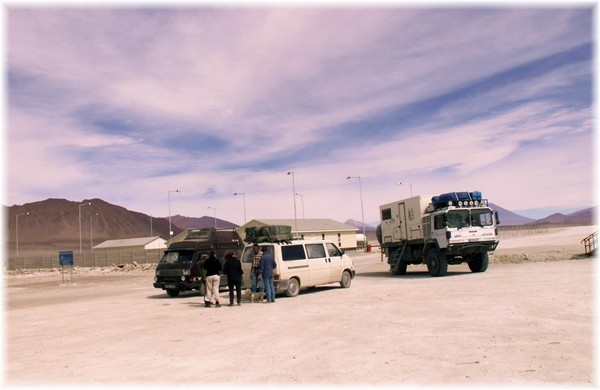
.... We say good bye to each other at the Bolivian border, knowing that we will meet each other in the next weeks or month somewhere again
Now we can start the adventure Bolivia. The next weeks we will be in the wild Southwest of Bolivia, if we will have no problems with the extreme climate, the thin air up on this altitude and the bad roads. We drive along bizarre rock formations, always the high mountains in our back, before we come in the evening to the town of Uyuni at the salt lake with the same name, “Salar de Uyuni”.
In Bolivia there are nearly no campgrounds. Out in the wilderness it is not a problem to camp, but in the cities you should not leave your car unattended. Either you park it at a 24 hour watched car park or directly next to the police station. We got the tip to park and overnight at the Hotel Misthel, where you can stay for the night on the back yard of the hotel for a few Bolivianos. We are happy to got this information, since it is already getting dark. Just on the next morning we see, where we have actually parked our car.
The place is anything else then a romantic place, but we are happy, that our car is parked save and we are in the middle of town, means we can do everything on foot. A few kilometres outside of Uyuni there is the so called train cemetery. Over the years they have stationed lots and lots of trains, where the trains are standing and rust. This place is not only of interest for train freaks and it is on foot just an hour away from town.
The main reason, why most of the tourists are driving this tiring long way up to Uyuni is, that everybody want to visit the worlds largest salt lake on an altitude of 3660 m. Certainly as well we are here for that reason and originally it was planned that we drive onto the salt lake with our own bus and overnight here.
When you drive onto the salt lake, a lot of salt stays on the underseal of the car and it is extremely hard to wash it away again and certainly the end of it is – rust. We don´t want to risk this and we therefore book a tour with a local agent for a daytrip onto the salt lake. The cost of this trip is 20 US Dollar per Person. At 11.00 am we start with a four wheel drive on the roads of the salt lake. Apart from the driver and a female chef are another 6 people on the car: a guy from Peru, one from Bolivia, a couple of Great Britain and we two. First we drive to the famous salt hotel which stands in the middle of the salt lake. Everything, apart of the thatched roof is made out of salt. From the tables to the chairs to the bed. After enjoying the salt hotel we go further on to the “Isla de los Pescadores” (the island of the fishermen)
Nobody can tell us where this island has it’s name from. There is a nice hike on the island up to the top, passing thousands of cactus. Meanwhile our female chef is preparing lunch, which is roasted meat, Quinoa and salad.
At around 5.00 pm we go back to Uyuni and at dawning we are at our “Romantic Hotel” again. The back yard where we are, is next to the military ground, where the soldiers have their rooms and it seems they love music. Every day at 5.30 am we wake up by the wakeup call of a trumpet. Half an hour later we listen to marching music. Well that is not all, actually they play and rehearsal the whole day and the room for it seems to be right next to our hotel. Even for me, as a former Musician it is to much and I am nearly getting mad. It is so much rehearsal that we skip preparing dinner and go out for dinner to one of the various restaurants in town. Choosing a meal, Michaela is much more open to new things then me. She is ordering meat of the Vicuña and lama with Quinoa, a typical grain from the plateau, while I mostly stay with beef and French fries. For a big good meal we seldom pay more then 5 Euro. In the late evening when we go back to our night camp we can feel the ice-cold wind coming from the salt lake. We know by then, it will be as cold as yesterday. Uyuni very often is called the fridge of Bolivia and we must say, this is right. Last night we had – 15° Celsius and even in the bus it was – 2° Celsius.
The only thing which helps after such a cold night is a pot of hot tea and the best is not to leave bed before sunrise. But in between an hour the sun is changing the frost to over + 20° Celsius. Shortly before we leave Uyuni we meet a Belgium family with four children, one of it is a 6 month old baby girl and they travel with a remodelled truck. They as well want to go over the salt lake with their truck. A few days later we’ve been told from other travellers, that they drove over the salt lake, but broke into it. 72 hours they had to wait, till help came and could pull them out again. After four days we leave now Uyuni and heading towards Potosi over the Cordillera de Chichas.
Next to a little village, at a lagoon, we find a place to camp for the night. Next day morning we look out the window and think we have problems with our eyes. We stand in the middle of a herd of about two hundred lamas. A female shepherd is just bringing them onto the field where we parked the car.
In that moment we are warmed up again from the sun we start to continue our travel. We pass small villages which are along our way. Most of the farmers here are poor and live from there herds of lamas. Sometimes we see herds of donkeys which are along the roads. Two times we have to pass small creeks, which used to be during raining season big rivers. Before we pass them, we always have to make sure, that we really can pass without problems. This means, we have to put off our shoes and as well the trousers and then we walk into the water. If the underwear is staying dry, we can do it with our bus as well, if not (speaking about 70 cm) we have to go all the way back in order not to damage the engine of our bus. Four weeks ago, we would not have had the chance to pass this creeks which in those times are rivers. Till now we always have been lucky. Shortly before Potosi we drive through a small canyon and then we reach the town about lunchtime.
Potosi, a town with 120 000nhabitants is on an altitude of 4070 m and is said to be next to the Tibetan town of Lhasa the highest city of the world. For us it is in the moment very important to know the exact altitude, to make sure we take always enough time to acclimate ourselves in order to lower the risk of having health problems.
We do not stay to long in the city with it’s silver mines. In the past time this city was one of the most important cities of the Spanish emporium in South America. The silver of the mines was covered with the sweat and blood from lots of Indians, but nevertheless it meant for Spain richness. Thousands of Indians did die in those times. Slavery, forced labour, exploitation of the people, that was a few hundred years ago. Die working conditions did not much change since the colonial time. Today the poverty let people work in the mines. We can’t believe it, that even today thousands of children are send by there parents into the mines for working. Very often they are not older then 12 years and they work up to 12 hours, starting from 7.00 pm till 7.00 am. After work they have to attend school and certainly are sleeping instead of learning. There bodies are already old by the time they reach the age of 20 and just a few of them will reach the age of 35 or 40. Most of them are dying of Silikose (dust lungs). Children’s work is by law forbidden even in Bolivia, but out of poverty the law does not count. Nobody persecute offences. We don’t want to look away and just tell you the beautiful sights and about the wonderful people we meet on our travel. This kind of themes you don’t find in any guide books. We don’t want to show you just the beauty of the country and the lovely people. In that moment you travel through Bolivia and be away from the tourist tracks you see the real country and you recognise the real live and how poor they are. Very often we get in contact with the poverty of this country. More about that during our report.
We want to be in Sucre before sunset, in a place which Gudrun and Volkmar recommended. It is a hostel in the centre of Sucre, called Pachamama where we can park our car as well on the backyard of the hostel. This hostel is done by a Bolivian family which really have a beautiful backyard.. There even is a green field where they constructed tables and chairs made out of sandstone. Anna, the owner of the hostel did take a lot of time and love into this small garden. All over are plenty of wonderful plants and flowers. And another positive aspect is with it: We can sit outside without wearing pullover and jackets since a long time, even though Sucre lies on an altitude of 2800 m.
Sucre is the official capital of Bolivia and the seat of the supreme court . The government businesses are done in the city of La Paz which is a city inhabited by millions of people. No city In whole South America you can´t find a city, build in the colonial style, which is as original like Sucre. It was build on seven hills, exactly like the city of Rome. It is as well called the white city due to the fact that the facades are white.
The city enchantes us.We have the feeling it is not a typical city of Bolivia. With it´s lots of students it really gets an international flair. If you would try to find a comparison it would be the Bolivian Regensburg (where we lived in Germany). We feel really homely in this city and every day we find another way to walk through. We have the feeling it will continue quiet a while.
We ask Anna, which restaurant she would recommend for a dinner. She send us over to a restaurant called the ”Oriental” where we are the only “white” people. At the entrance there is a big plastic bowl. The size of it is so big that we in Germany would wash children in it. In there is a brown fluid which reminds us to liquid manure. All of the guests in the restaurant get one glass of it, we are not brave enough to try it. Instead we ask for two beers which the waitress is going to fetch for us over the street. There is no menu, only chicken with potatoes. Michaela order a quarter of a chicken, myself a half one. My chicken is so big that the plate where it is on, is not big enough. Michaela is starting to laugh and can’t stop to do so. We can’t remember that we ever would have seen a chicken as big as this is. The air in the restaurant is hot and sticky. At the open window, we recognize a man, a beggar, who stands there in trying to get eye contact with the guests of the restaurant. For most of them this man is invisible. I try to get eye contact with him and give him a sign that he knows, we will take care tonight for some food for him. Half of a chicken with lots of potatoes we let us rap like a doggy bag. At the exit he is already waiting and thanks us a thousand times and explains, that he need the food not for himself but for his kids. In Argentina and Chile we did feed the dogs. Here the people need some support.
Next day we meet Bruno, a French guy who is our age.
He lives since a few month already in the same hostel were we stand with our VW-bus. Bruno is a nurse and works as a volunteer, not even get paid for accommodation and food. He takes care about 150 children out of 2000 children which are living on the street here in Sucre. The parents of this kids leave them here in order to find a job in Argentina or Chile. Most of the parents never come back to Bolivia and so the kids have to make there own life. He tells us about his work. Michaela is one time visiting the Centre, were the kids can stay during the day and where they get warm meals and been looked after by some street workers. If they have any health problems, Bruno takes care about this. Michaela give her old shoes to the Centre, since she bought new ones and a girl which have been wearing till now Sandals during Summer and Wintertime have new ones.
Five days before we leave Sucre there is happening a tragedy. A small bus which brings Tourists from Sucre to the Sunday market in Tarabuco, get involved into an accident. Most of the tourists being in that bus, get hurt and unfortunately one Canadian girl (20 years old) dies. As well from our hostel there are some tourists involved and upon arrival of the news Anna the owner of the hostel as well then Bruno, the nurse, are heading to the hospital were the tourists have brought to, for translating and help were they can. Late at night they are back again. Bruno is doing his work as a nurse now in the garden of the hostel, while Anna is looking after them like a mother.
We are changing the theme now.
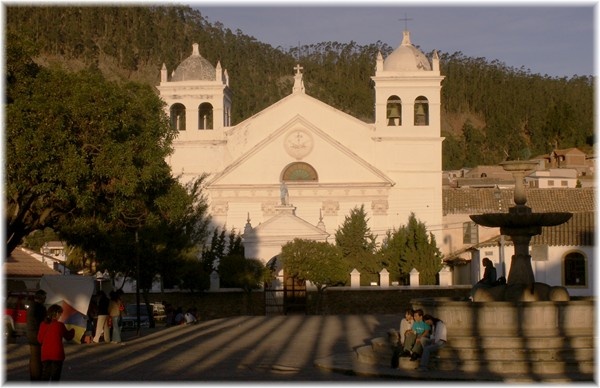
... the monastery of San Franciscans with the monastery church La Recoleta, one of 22 churches and chapel’s from the Spanish colonial time which are still here in Sucre
Late in the afternoon, when there is the sunset, we often go up to the Convento La Recoleta, a 400 year old San Francisco monastery. From up here you have a terrific view down to the city and it is really quiet, different then being down in town. We meet here Sanjosa and other Indigenas, which are selling there homemade waved textiles to the tourists
We tell them about our families, how life is in Germany and Europe. Once we tell them, that in the very North of Europe there is no sunset for a few month, they start to laugh and do not believe us. More and more Indigenas are sitting together with us and listen to our stories and ask thousands of questions. At the end they want to know, if we will come back tomorrow again. We really have lots of fun with them.
On our journey we never stayed as long as here. The city and the people here are so friendly, so warm hearted that the last 18 days were passing by quick. But we want to see more of this country and therefore it is time for us to leave. We put this travel report in the net, before we leave, since we don’t know when we will have the next possibility.
Hasta luego!
Raimund and Michaela

